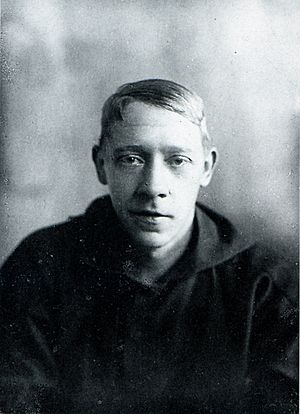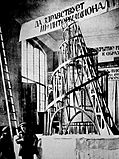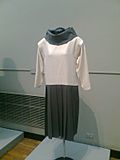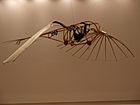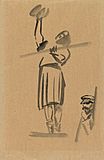Vladimir Tatlin facts for kids
Vladimir Tatlin (born December 28, 1885 – died May 31, 1953) was a famous Russian and Soviet artist. He was a painter, an architect, and a designer for theater stages. Tatlin became very well known for designing a huge building called The Monument to the Third International, often called Tatlin's Tower. He started this design in 1919. Along with Kazimir Malevich, he was a key artist in the Soviet avant-garde art movement in the 1920s. Later, he also became important in the Constructivist art style.
About Vladimir Tatlin
Vladimir Yevgrafovich Tatlin was born in Moscow, Russian Empire. His father, Yevhraf Nikoforyvych Tatlin, was a mechanical engineer. His mother, Nadezhda Nikolaevna Tatlina, was a poet. She supported a revolutionary group called Narodnaya Volya.
After his mother died in 1887, his father remarried. They moved to Kharkiv. Vladimir's father passed away in 1904. This meant young Vladimir had to stop his art studies. He left for Odessa to become a merchant sea cadet. He said that the sea and faraway lands gave him inspiration. He sailed across the Black Sea and even to Egypt.
In 1905, he began studying at the N.Selivestrov Penza Art School in Penza. He finished his studies there in 1910. During summer breaks, he visited Moscow and St.Petersburg. He took part in different art events there. In 1911, he moved to Moscow to live with his uncle. He started his art career by painting icons. He was also a professional musician. He sang Ukrainian songs and played the bandura. He even performed abroad.
Tatlin's Tower Design
Tatlin learned about the art of Pablo Picasso during a trip to Paris in 1913. Tatlin became famous for designing the huge Monument to the Third International. This building is also known as Tatlin's Tower. Tatlin started designing it in 1919.
The monument was meant to be a very tall tower. It would be made of iron, glass, and steel. It was designed to be much taller than the Eiffel Tower in Paris. Tatlin's Tower was planned to be 400 meters high. This is about a third taller than the Eiffel Tower.
Inside the iron and steel spirals, there would be three glass buildings. These parts would spin at different speeds. The first part, a cube, would turn once a year. The second part, a pyramid, would turn once a month. The third part, a cylinder, would turn once a day. The whole building was supposed to be a center for the Comintern. It would be used to create and share new ideas. However, the tower was never built. This was because of money and practical reasons.
Constructivist Art
Tatlin is also seen as a founder of Constructivist art after the Russian Revolution. He created "counter-reliefs" before the revolution. These were 3D artworks made from wood and metal. Some were placed in corners of rooms. Others were placed in more usual ways. Tatlin made these sculptures to challenge old ideas about art. He did not call himself a Constructivist. He disagreed with many of the movement's ideas. Other important Constructivist artists included Varvara Stepanova and Alexander Rodchenko.
Tatlin and Kazimir Malevich were colleagues early in their careers. But they had strong public arguments. This happened at the 0.10 Exhibition in 1915. This show was also called "the last futurist exhibition." Their arguments were about Malevich's 'suprematist' artworks shown there. This led Malevich to develop his ideas further. He started an art school called UNOVIS in Vitebsk.
Tatlin also studied clothes and other objects. He was very interested in flight. This led him to build a personal flying machine called Letatlin.
In 1930, he taught in Kiev. One of his students there was Joseph Karakis. From the 1930s, Tatlin worked for different theaters in Moscow. During the Great Patriotic War, he worked in Gorkiy. He also worked with many Soviet art groups. This included the Fine Arts department of Narkompros.
In 1948, he was criticized for his ideas. He lost his job but was not put in prison. Tatlin died in 1953 in Moscow. He was buried at the Novodevichy Cemetery.
Gallery of Works
-
Tatlin, 1929-1931: Letatlin № 1., sculpture; human-powered ornithopter
See also
 In Spanish: Vladímir Tatlin para niños
In Spanish: Vladímir Tatlin para niños


